The House of Cats and Dice is back to two cats! Sticking with virtual dice-rolling for now, but the outdoor adventures continue! We like wildlife, photography, and wildlife photography. Will be posting local critters and birds, along with sunsets, zoo critters, and flowers as the mood strikes.
Don't wanna be here? Send us removal request.
Text
American Bullfrog, Lithobates catesbeianus
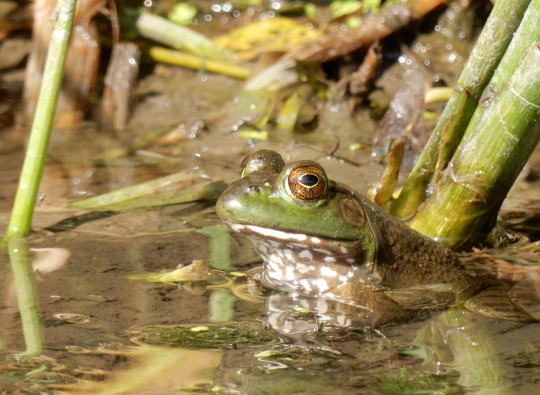
This was taken a couple of summers ago at our favorite lake. Many of the frogs at the water’s edge zoomed away as I approached, but this guy just stared at me, unimpressed.
0 notes
Text
Great Blue Heron, Ardea herodias
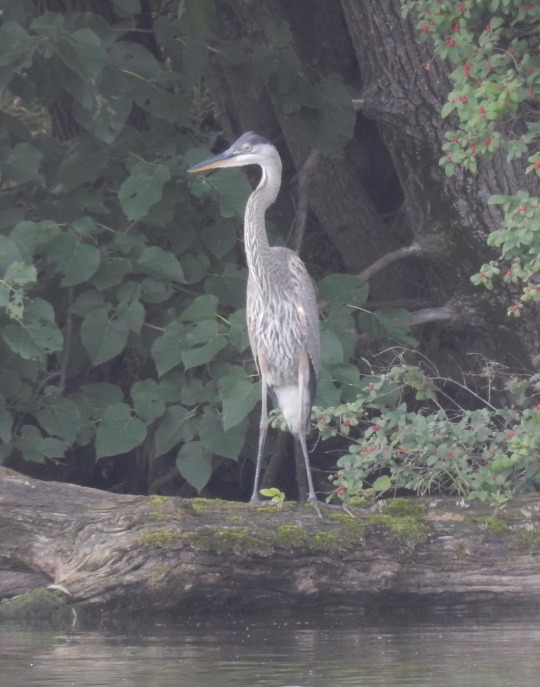
There were SO many of these guys at the lake Saturday! The lake is known as a good fishing spot, and apparently the herons agree.
GBH are very common, and the only reason I haven’t posted one before now is that I didn’t have a good picture. Despite their size and spear-like bill, they’re very leery of people, and will take off if you get too close. This was taken at max zoom on my little point-and-shoot.
Remember the kingbird I posted a while ago, good old Tyrannus tyrannus? A pair of them had claimed a fallen tree over the water, and we saw them chasing a couple of herons away. It’s a trip to see little sparrow-sized guys harassing these dinosaurs!
1 note
·
View note
Text
Black-crowned Night Heron, Nycticorax nycticorax
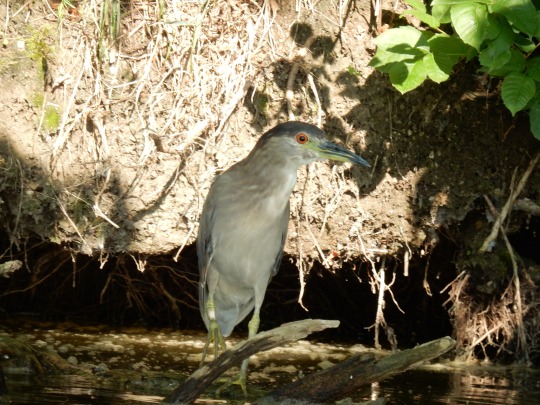
Another cool binomial! Paddling around on a new lake this morning, I saw this little guy behind some overhanging branches at the edge of the lake. I thought he was a Green Heron, possible a juvenile, and snapped a few pictures before moving off. He seemed nervous, and I didn’t want to scare him out of cover.
Got home, looked at the photos, and whoa, look at that red eye! Green Herons have yellow eyes, and even the juveniles have some brown streaking on the chest and sides.
A bit of research turns up the Black-crowned Night Heron. This guy would be considered “immature” — not a full adult yet, but older than juvenile. I feel lucky to have spotted him, because, as the name suggests, they’re most active at dusk.
0 notes
Text
British Soldiers, Cladonia cristatella
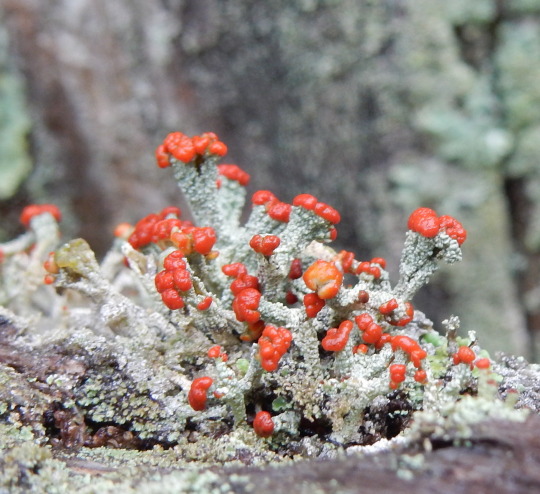
Lichens are super cool! For those who haven’t looked into lichens before, they’re symbiotes, part fungi and part algae or cyanobacteria. Literally there are two distinct species living together, and lichens take the scientific name of the fungus part. The algae or cyanobacteria lives inside and gives the fungus energy via photosynthesis, and the fungus protects it in return. A good partnership!
0 notes
Text
Spiny Puffball, Lycoperdon pulcherrimum
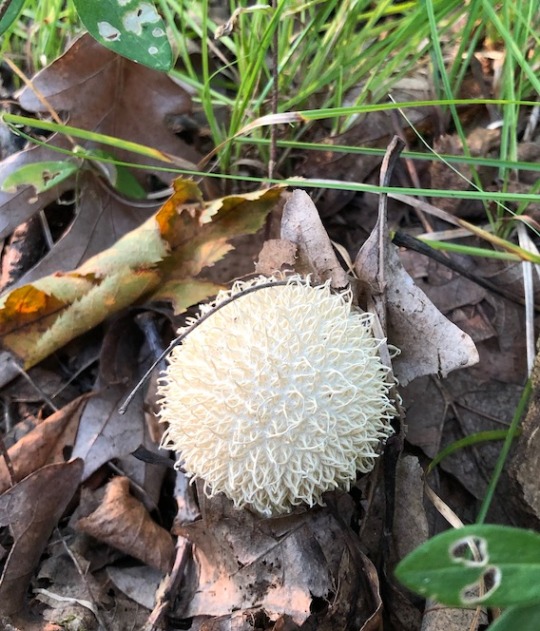
Funky little ‘shroom with a thick, short, tapering stalk, almost like an upside-down vase. There are a couple of different species called “Spiny Puffball” colloquially, but I think I’ve got the right one for my neck of the woods. Saw a few Giant Puffballs too...those are some massive fungi.
1 note
·
View note
Text
Grasshopper Sparrow, Ammodramus savannarum
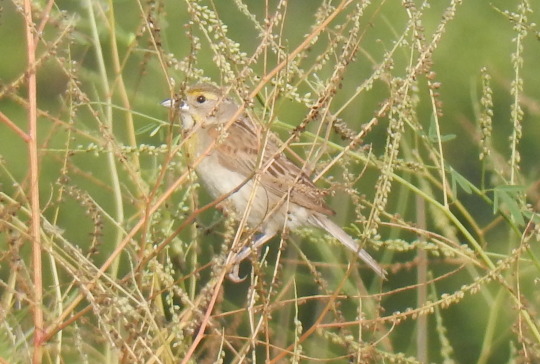
I’m 90% confident in this ID. The grasshopper sparrow is listed as “uncommon & local” in my field guide, but I don’t see anything else it could be. Most meadow sparrows have striped breasts, and he’s just buffy underneath. There’s the yellow eyebrow, which would fit the ID. To mirror the field guides, he’d need to be darker on the back and have a yellow patch on the leading edge of the wing...but it was bright out, so the camera might have washed him out a little. Plus it seems that the species has some variation; the Florida type is darker, and somewhat endangered. We’re in the Midwest, which fits in terms of typical summer range. Sometimes you just gotta give it your best guess...
1 note
·
View note
Text
Eastern Box Turtle, Terrapene carolina carolina
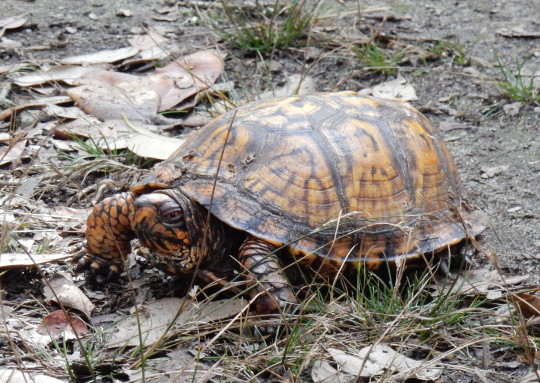
What a face! Found this guy on a forest walk in the Outer Banks. I wasn’t expecting to find a forest out there, but it turns out there are four protected “maritime forests” on the islands. The box turtles are called that because they can pull in their head and extremities and hide inside their shells.
0 notes
Text
Great Black-backed Gull, Larus marinus
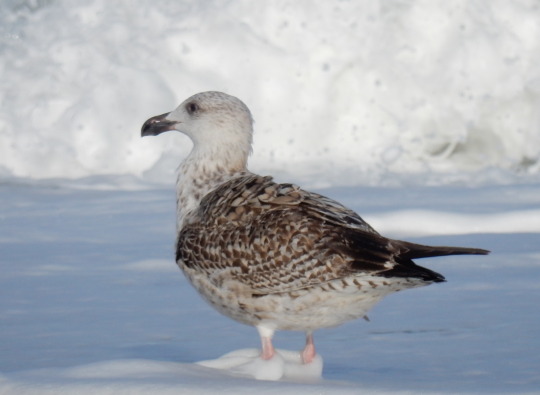
In yesterday’s post, I mentioned that gulls can be hard to identify. I studied this picture for a good long time before I decided that this guy is a Great Black-backed Gull heading into his second winter.
The location/season is North Carolina in November. Several types of gulls winter in that area, including the GBBG.
I thought he might be a Herring Gull, but HG juveniles have more brown on their heads, and second-winter ones begin having gray backs, and more pink on the bill.
Lesser Black-backed Gulls have yellow legs, and this guy clearly has pink legs. He was much bigger than the Laughing Gulls I posted yesterday. So, I’m going with the identification at the top!
0 notes
Text
Laughing Gull, Leucophaeus atricilla
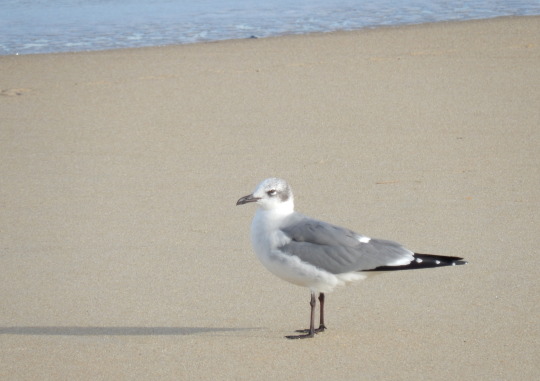
Gulls are among the more challenging birds to identify. Most are various shades of white, black, and gray. Many gulls have a distinctly different pattern when they’re juveniles, and some have different juvenile color schemes depending on how old they are. You’ll see ID photos labeled “first winter,” “second winter,” and so on.
This fellow here, the Laughing Gull, has a completely black head during breeding season. But in non-breeding season, like in this pic taken in November, they go white and gray instead.
0 notes
Text
Brown Pelican, Pelecanus occidentalis
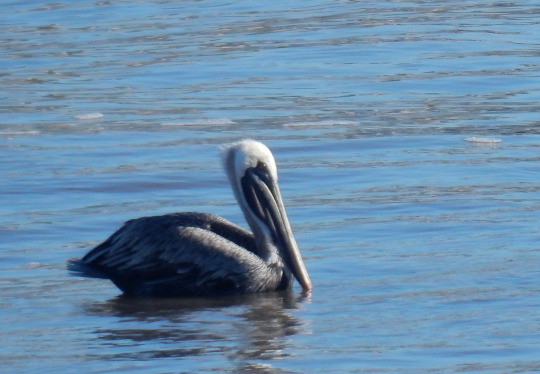
All About Birds describes the brown pelican as “comically elegant.” I have to agree! They’re large, ponderous, dignified, and slightly ludicrously proportioned birds. But hey, that’s just my human opinion, and the shape seems to work quite well for these expert fishers.
0 notes
Text
Komodo dragon, Varanus komodoensis
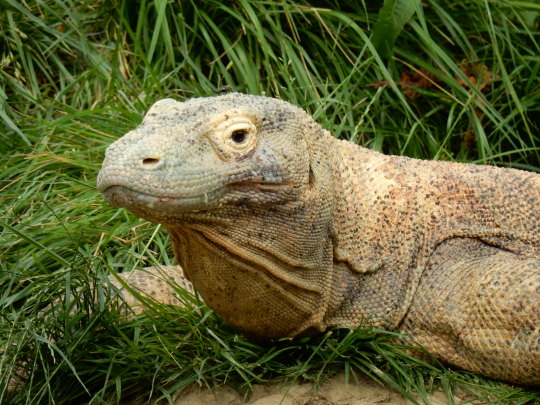
I have a fondness for lizards, but many of them are very quick, and thus hard to photograph. But behold: the world’s largest monitor lizard, aka the Komodo dragon. It’s much easier to take a portrait of these guys. Although on one visit to the zoo, we lucked out and arrived at the dragon exhibit at feeding time, where we learned these chonky lizards can move fast when they feel like it!
0 notes
Text
White Ibis, Eudocimus albus
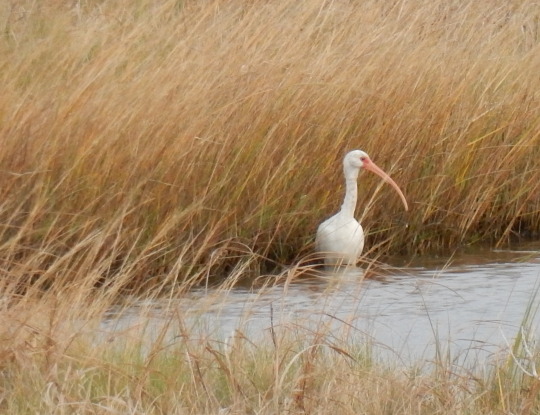
Looks a lot like the scarlet ibis I posted yesterday, doesn’t it? They’re almost exactly the same, down to their bones. Only the color is different. Classification nerds like to argue about whether the white ibis and scarlet ibis are really different species, or two color variations of the same species. White ibis are found along the coasts of North & Central America, while scarlets range mostly along the northeastern coasts of South America. They can interbreed, but generally don’t. *shrug* Science would be dull if everything was cut and dried. I’m glad there are things we’re still working out!
0 notes
Text
Scarlet Ibis, Eudocimus ruber
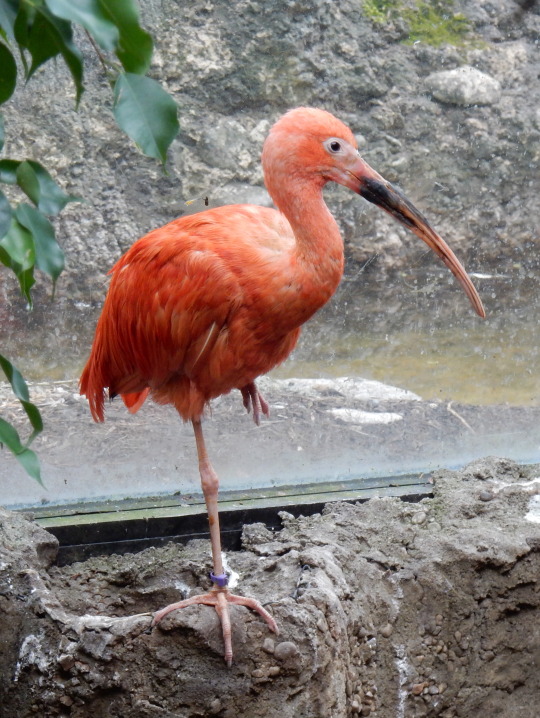
One of the best things about the Cincinnati Zoo is the “Wings of the World” exhibit. There are a couple of very large areas where you can observe several sorts of birds together. The more patient you are, the more birds you can spot. This one’s pretty hard to miss, though!
0 notes
Text
Queen Snake, Regina septemvittata
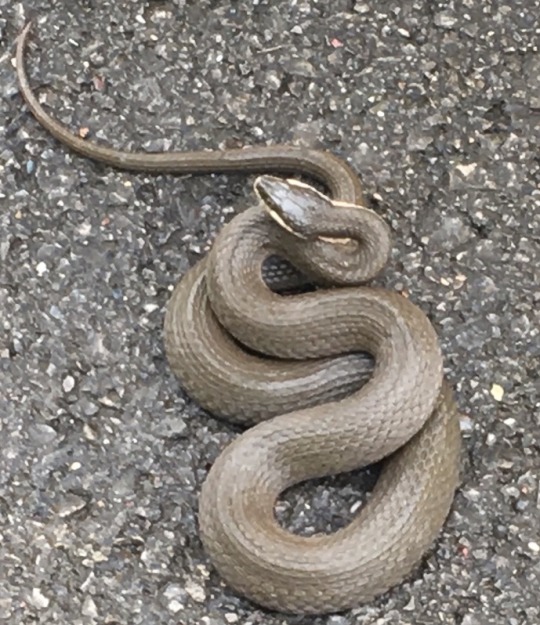
Found this little guy (or gal) stretched out across a bike path in Kentucky. He went into defensive mode when I got close. He’s got a quick little snapping strike! I didn’t want to bother him, but I also didn’t want him to get run over, so I gently lifted him with a stick and set him on the side of the path, in the direction he was headed.
That direction, incidentally, was toward the creek that runs along that bike path. It’s a neat little creek, fairly healthy for being in a suburb. We’ve seen herons, ducks, crayfish, and turtles hanging out there. And as it happens, queen snakes primarily eat crayfish. You can see in the pic that our snek friend has some large flat scales on the top of his head. It’s thought that they stick their noses under rocks and lift, to reveal any tasty snacks that might be hiding underneath.
0 notes
Text
Mourning Dove, Zenaida macroura
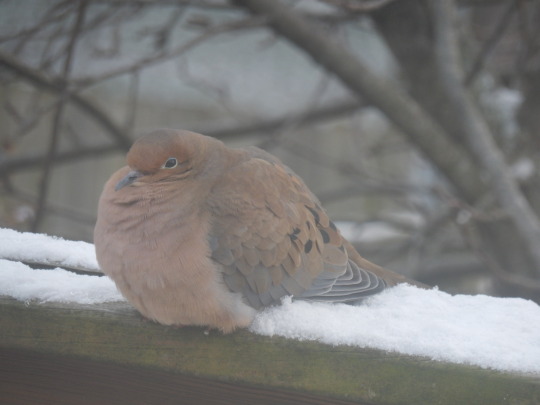
Mourning Doves are usually quite sleek, but this was a bitterly cold day. Maximum poof!
2 notes
·
View notes
Text
Colorful feeder trio in November
Top to bottom:
Black-capped Chickadee, Poecile atricapillus
White-breasted Nuthatch, Sitta carolinensis
American Goldfinch, Spinus tristis
I think the goldfinch is a female. Both male and female go a little drab when it’s not breeding season. The breeding season males are so yellow, we’ve nicknamed them “lemon finches.”
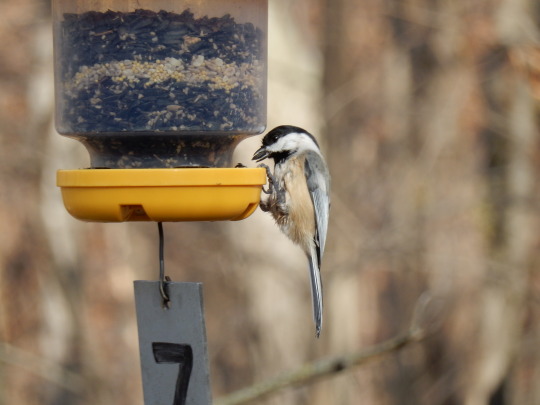
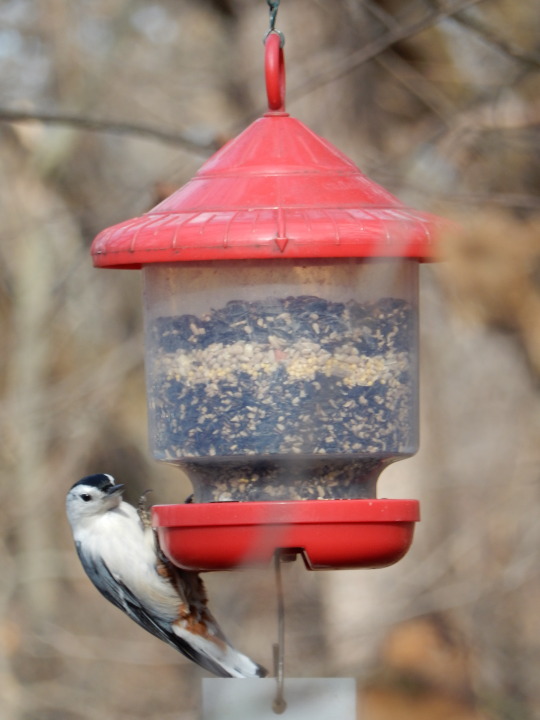
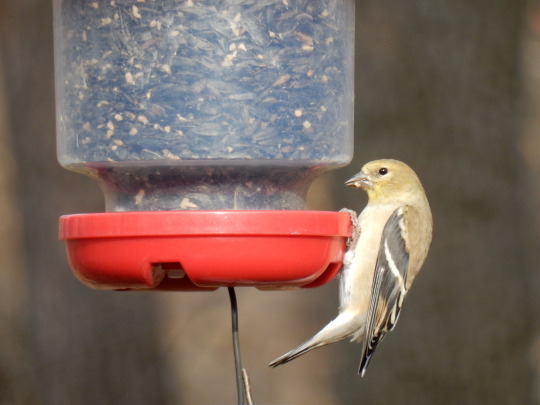
0 notes
Text
Pallas’s Cat, Otocolubus manul

This is another Cincinnati Zoo pic. I adore these guys. They’re so unusual! I believe this is the only feline whose eyes have a round pupil instead of a slitted one.
10 notes
·
View notes